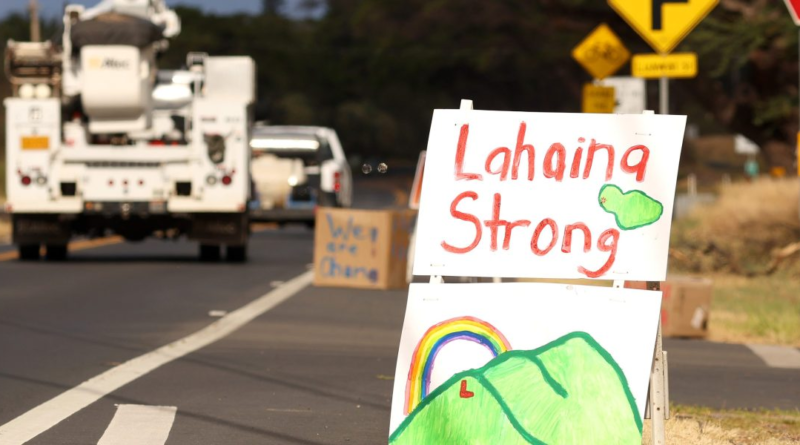Amid climate disasters and despite its own tragedy, Hawaii provides a model for community-centered innovation
Hawai’i has long been on the leading edge of climate innovation, but in August, we found ourselves on the tragic edge of climate impact as the deadliest U.S. wildfire in over a century tore through Maui. The fires stole the lives of 97 people and destroyed multi-generational homes and cultural history. As residents start to return to the area, we see how much has changed.
As we grieve, we also confront reality: This fire wasn’t an isolated incident but the symptom of a global crisis. Extreme heat, drought conditions, and massive storms all played a part in throwing Hawai’i into the epicenter of the climate crisis. And while the fires came for Hawai’i in August, and floods and storms for New York in the fall and winter, communities in every corner of the world are poised to face similar climate disasters. Last September was the hottest one on record (the fourth consecutive month of such unprecedented heat) and 2023 has been the hottest year in recorded history.
It’s important that we do not just see Hawai’i as another grim omen. Our islands should also be looked to for examples of how community-centered innovation can help build resilience and strength.
As an island community, Hawai’i has long been a hub of innovation–from ingenious land and marine resource management to energy infrastructure. In a world where supply chains are shortening and localized climate impacts are growing, solutions have to address local needs because no two communities are alike. Technology and innovation need to be evaluated, prioritized, and adopted by the local communities that are closest to the climate problems they face. So as groups across the world consider how to build local resilience, examples emerging from Hawai’i can serve as a starting point.
Innovation in decentralizing energy
Hawai’i was the first state in the U.S. to set a goal of 100% homegrown renewable energy. While there is still ground to be covered, tremendous progress has been made. In fact, on the day of the Lahaina fire, the neighboring island of Kaua’i’s grid was operating with 100% renewable power. This independence is increasingly allowing communities to create energy in a way that aligns with the ecological, economic, and cultural needs of the people who use it. It minimizes reliance on world energy markets and increases wealth creation locally.
In the wake of the fires, local communities want innovation to bring energy resilience to the household scale. Residential solar panels and home batteries can allow utilities to shut off grid power during high winds and fire conditions without throwing customers into the dark. Some electric vehicles can now plug in and power homes and medical devices even if the grid goes down after a major storm. Energy innovation can bring more than lower bills and cleaner air–it can also advance public safety.
Innovation in disaster response
Innovation is also driving critical emergency response actions on the ground in Hawai’i. Emergency solar generators were installed in Lahaina to provide clean, quiet power to community disaster distribution centers. Residents tried revolutionary solar-powered water panels that can provide clean drinking water from humidity in the air.
Maui County was in the process of developing Resilience Hubs–community centers that can provide shelter and services even if the grid goes down–in local communities when the fires hit. These will still move forward, and innovators using AI to model future climate risks and provide data can help local communities plan where and how resilient infrastructure should be rebuilt.
Innovation in restoring healthy systems
Lahaina is already having conversations to restore a relationship with the land that surrounds the community and nurtured and protected people in the past. There’s a role for innovation here, too.
Studies show that restoring native forests and active agriculture in the dry, fallow lands around fire-prone communities can not only create green buffer zones but literally help bring back the rain. New technologies can facilitate better, more resilient forest planting and increase regeneration success rates. Online markets can support local agriculture by providing a new storefront for farmers who establish crops on fallow land, which can reduce the risk of wildfires.
It’s not just Hawai’i–every local community needs to restore the health and resilience of the landscapes that surround and protect us. Increasingly extreme weather will impact all of our communities. Locally relevant technologies can help restore the relationship between people and the places we live.
The innovative work being done in Hawai’i shows multiple ways that community-based climate technology development can help respond to and plan for future climate disasters across the U.S. and the world.
The only way through tragedy is together. When communities are centered in the discussion to combat climate change, they can build resilience to face the unprecedented amount of change coming towards us. In Hawai’i, we know that our deep history of local innovation is more important than ever to ensure a resilient future for our islands–as well as island Earth.
Dawn Lippert is the founder and CEO of Elemental Excelerator, a nonprofit focused on scaling climate technologies with deep community impact. Josh Stanbro is deputy director of Policy Lab at Elemental Excelerator and the former Chief Resilience Officer of Honolulu.
More must-read commentary published by Fortune:
The opinions expressed in Fortune.com commentary pieces are solely the views of their authors and do not necessarily reflect the opinions and beliefs of Fortune.




